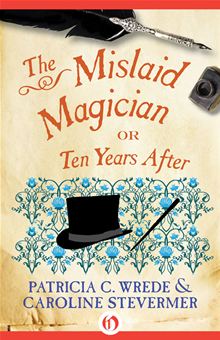The Mislaid Magician, or, Ten Years After, by Caroline Stevermer and Patricia C. Wrede
Nov 6
2006

Caroline Stevermer and Patricia C. Wrede’s 1988 novel Sorcery and Cecelia was a delightful curiosity—a cult favorite that appealed equally to devotees of Diana Wynne Jones and Georgette Heyer. The book's two sequels, 2004’s The Grand Tour and the just-released The Mislaid Magician, don’t totally recapture the magic of the first story, but they still make for very entertaining reading.
Stevermer and Wrede’s series began as a game that involved the authors writing letters to one another in character. Stevermer’s chosen persona was Kate, a Regency-era young lady enjoying her first London season, while Wrede wrote as Kate’s cousin Cecelia, stuck in the country awaiting her own social début. Although the setting of their series will be familiar to any historical romance fan (balls, Almack’s, Vauxhall), Stevermer and Wrede’s Europe also featured some very powerful magicians, making their stories more about magical adventures than social ones.
The Mislaid Magician takes place ten years after the events of the first two books, and is composed of letters from Kate, Cecelia, and their husbands, James and Thomas. The plot is complicated: there are lines of magical energy doing something weird to the fledgling railways, missing surveyors, and (oddest of all) Kate’s flighty sister has made an unexplained visit to the country—right in the middle of London’s social season! The plot was so ambitious, in fact, that I was forced to go back and re-read several chapters in order to understand what had happened.
Still, the appeal of Wrede and Stevermer’s series has never been about complicated plot maneuvering. It’s about the cousins’ wry sense of humor, their staunch friendship, and the joy of poking one’s nose into somebody else’s correspondence, and The Mislaid Magician delivers on all counts. Sure, it’s only about half as charming and original as the first book in the series… but that means it’s still about twice as much fun as most “alternate history” fantasy.
Stevermer and Wrede’s series began as a game that involved the authors writing letters to one another in character. Stevermer’s chosen persona was Kate, a Regency-era young lady enjoying her first London season, while Wrede wrote as Kate’s cousin Cecelia, stuck in the country awaiting her own social début. Although the setting of their series will be familiar to any historical romance fan (balls, Almack’s, Vauxhall), Stevermer and Wrede’s Europe also featured some very powerful magicians, making their stories more about magical adventures than social ones.
The Mislaid Magician takes place ten years after the events of the first two books, and is composed of letters from Kate, Cecelia, and their husbands, James and Thomas. The plot is complicated: there are lines of magical energy doing something weird to the fledgling railways, missing surveyors, and (oddest of all) Kate’s flighty sister has made an unexplained visit to the country—right in the middle of London’s social season! The plot was so ambitious, in fact, that I was forced to go back and re-read several chapters in order to understand what had happened.
Still, the appeal of Wrede and Stevermer’s series has never been about complicated plot maneuvering. It’s about the cousins’ wry sense of humor, their staunch friendship, and the joy of poking one’s nose into somebody else’s correspondence, and The Mislaid Magician delivers on all counts. Sure, it’s only about half as charming and original as the first book in the series… but that means it’s still about twice as much fun as most “alternate history” fantasy.
Posted by: Julia, Last edit by: Julianka
No new comments are allowed on this post.
Comments
hecate
I love this series, and I'm glad they're back to the letter-based construction (the second book was told diary-style, which I thought made the romantic scenes a little weird--you might tell your best friend about progress with the object of your affections, but who would record that stuff in their "commonplace book"?)
hecate
I love this series, and I'm glad they're back to the letter-based construction (the second book was told diary-style, which I thought made the romantic scenes a little weird--you might tell your best friend about progress with the object of your affections, but who would record that stuff in their "commonplace book"?)